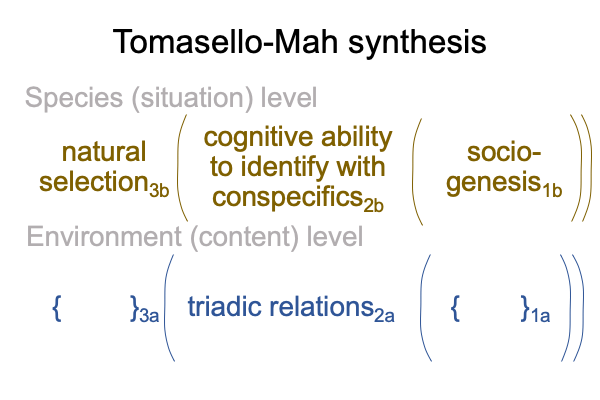0017 The previous diagram poses a difficulty.
What is the actuality that potentiates sociogenesis2a, other than a society generating environment2a?
Does this sound like a tautology?
A tautology is an argument that concludes with its founding assertion.
This banana must taste good because all bananas taste good.
0018 Ah, does this mean that Tomasello cannot articulate the actuality independent of the adapting species2a because he has already placed a curtain over it that says, “Here is a society generating environment1b.”?
For most species2b, the actuality2a underlying the niche1b is a material or instrumental condition2a that is readily observed and measured by biologists. For the hominins, the content-level actuality2a is not so obvious. Indeed, it is so hidden that evolutionary theorists presume that sociogenetic potential1b already exists because the last common ancestor (LCA), like the contemporary chimpanzee and bonobo, lives in small bands. The capacity for culture1b is already present.
0019 By 2016, Tomasello figures out one apparent cause for increasing sociogenetic potential. Hominins need to work together to obtain food. This is a very good idea. It also appears in Razie Mah’s e-article Comments on Clive Gamble, John Gowlett and Robin Dunbar’s Book (2014) Thinking Big (available at smashwords and other e-book venues). Australopithecines start to work in teams in order to gather more food than each would acquire foraging alone. In short, working in a team guarantees survival in a way that working alone does not.
This proximate cause does not satisfy the issue at hand. Is there one foundational niche for hominins, such as the sea for dolphins, the air for bats and the web for the spider? Is there an actuality independent of the hominins2a that contains the potential to generate society1b?
0020 Razie Mah proposes an answer to this question in the masterwork The Human Niche (available at smashwords and other e-book venues). Triadic relations constitute the actuality independent of the hominin species2a. Triadic relations for humans is like the sea is to the dolphin, the air is to the bat and the web is to the spider. The only difference is that the sea, the air and the web are obvious material and instrumental conditions. The scientist can observe and measure them. In contrast, triadic relations are neither material nor instrumental. They are immaterial beings that entangle material and instrumental causalities. They cannot be directly observed by scientists, although their entanglements can be measured.
If a scientist cannot directly observe or measure a triadic relation, then do triadic relations really exist?
That is a funny question.
0021 Triadic relations2a are so real that they potentiate sociogenesis1b in hominin evolution. Triadic relations2a make adaptive social relations2b possible1b. Plus, triadic relations2a are in play in every proximate niche1b. Triadic relations2asupport an ultimate niche1b. Proximate niches support divergent evolution. Ultimate niches support convergent evolution. Hominin evolution is at once divergent and convergent.
If I may be so bold as to present the resulting figure as the Tomasello-Mah synthesis for the natural history of hominins.

